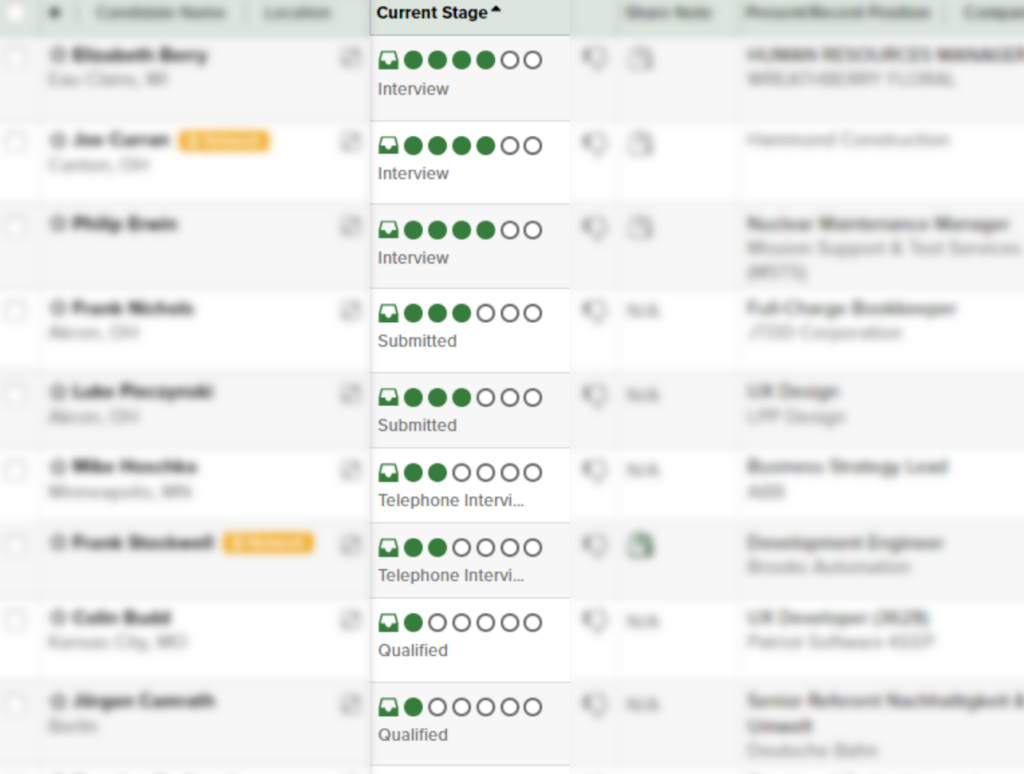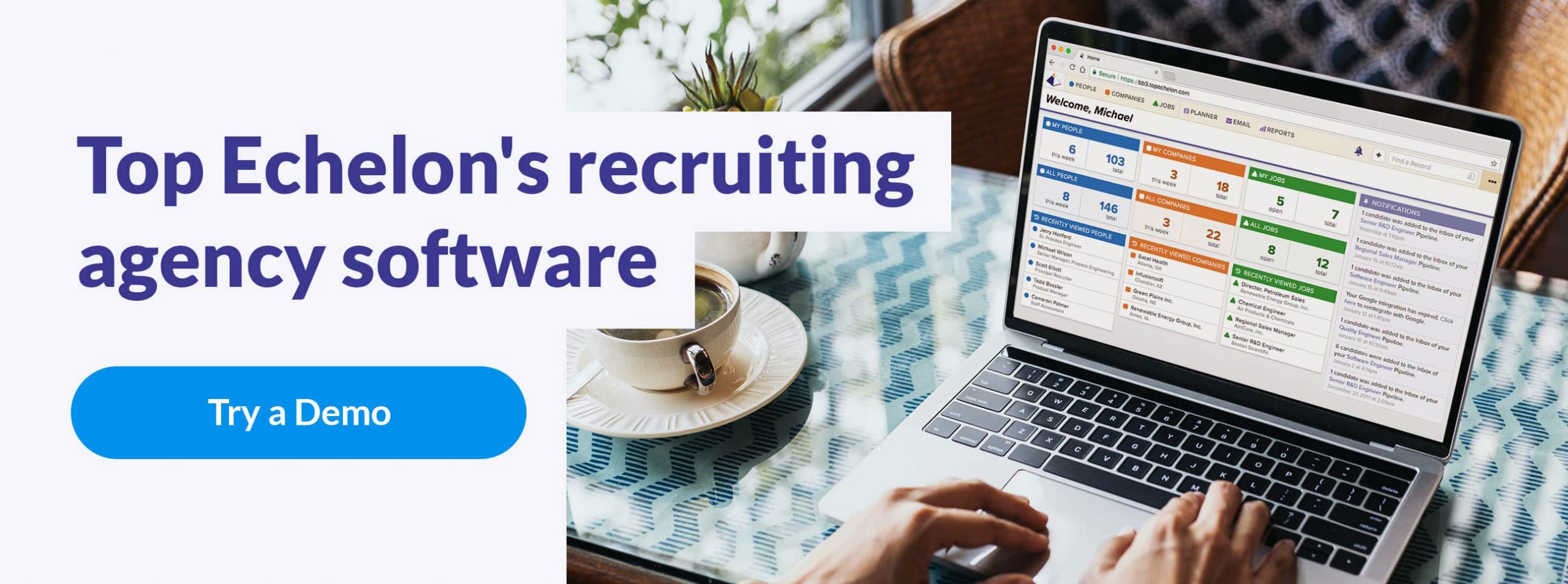Applicant Tracking System & the Screening Process
When it comes to the hiring and recruiting process, it can be looked at as sort of a funnel. Any productive recruiter will have a pipeline filled with candidates. This pipeline will start at the top with prospective candidates and lead all the way down to the bottom with the narrow shortlist of “most placeable candidates” or MPCs.
The beginning of the process however, can be the most important as you start to put candidates into your pipeline. Along with opening up the floodgates of your applicant tracking system, you have to ensure you’re getting the candidates you actually need. This is where the magic of the screening process comes into play.
Applicant Tracking Systems and Recruitment Pipelines
As mentioned earlier, workflows or pipelines are the ways in which recruiters utilize ATS systems to their advantage. Organizing and customizing these pipelines allows for recruiters to keep track of their most valuable asset: candidates.
The typical pipeline for recruiters can range anywhere from a few stages, to upwards of 10+. An example of what these look like in Top Echelon Recruiting Software can be seen in the following image:
An important thing to consider in this area is making sure that the candidate experience is kept optimal, and making sure that your stages aren’t too lengthy. Having too many recruiting steps or stages that last multiple weeks or months can make candidates feel drained. Ultimately, this comes back to how you start off your recruitment process: screening.
The Importance of Screening Candidates
To achieve your goal of finding the best candidate for a role, you may think that you need to cast a larger-than-life size net into a giant pool of candidates. The size of your search doesn’t matter, it is the quality of your candidate pool that matters most. This is why screening and storing qualified candidates stashed in their applicant tracking system is so beneficial for recruiters.
In order to hit all the key areas of a solid screening stage, you might consider the following some targets to aim your questions:
- Work experience, and how it applies to a given role
- Personal Development, and what goals a person may have for growth in the future.
- Work environment, and what situation is ideal for work purposes.
- Personal work style, and how your work style may fit into a company, team or workflow.
- Deadline and high-pressure questions, and trying to figure out how somebody deals with pressure in a fast-paced environment.
- Responsibilities, and what sorts of tasks has the candidate been responsible for in the past.
- Organization, and how do they maintain some sort of organizational method to keep themself ready for responsibilities thrown their way.
With these sections in mind, it is really this first step – screening – that determines how the rest of your pool gets selected and vetted. At this stage, candidates are typically spoken to over the phone for no more than 30 minutes. The goal of this screening process is to learn more about candidates before there is time spent on any interview process.
Among a list of most common screening prompts could be:
- Tell me a little about yourself
- What are you looking for in your next role?
- What applicable experience/s do you have as it relates to this role?
- Where do you see yourself professionally in x years?
- What accomplishments are you most proud of?
- How did you hear about this position?
- How soon would you be able to start?
- What are your compensation expectations for this role?
With strong screening questions at your disposal, you can be ready to get a decent snapshot of any prospective candidate. As it leads you into the rest of your recruitment process, this essential step really helps get you a better understanding of candidates.
Screening Stage in Practice
For many recruiters, it really all depends on what practices they are most comfortable with. For some, a simple call to screen candidates can last anywhere from 15 to 30 minutes in length. For others, it is best to have questionnaires setup at the time of application in order to understand a candidate beyond their resume and cover letter.
With the evolution of technology and the advancement of applicant tracking systems for recruiters, we will continue to see developments that optimize candidate screening. A few examples of screening trends are:
- Psychometric identifiers, or getting to know somebody based on their personality traits. Some application portals are giving applicants a relatively short questionnaire to figure out things such as extraversion vs. introversion, to see how they may fit in at a given company or team.
- Referrals, or giving the chance to candidates to utilize any connections they may have within a given company. Many companies have started to take notice that referred workers tend to stick around longer and are more successful, so this would definitely be a focus early on in a recruitment process.
- Work setting situation, or getting an idea of what workers prefer. Combine COVID and the great resignation, and many workplaces are between fully in-office, hybrid work and fully remote working. There are going to be preferences on the company side, as well as the candidate side typically – so with world events rapidly changing and evolving, this will continue to be part of a screening process in some fashion.
How to use an ATS during or after screening?
Once all is said and done, you have gotten to speaking with a candidate and you have learned more about them. All the notes and extra information that you’ve gathered should be added to your candidate’s profile. Typically through recruiting software, all this information will be searchable in your database and you can utilize it as you continue your recruitment.
Conclusion
For much of recruiting, there are going to be evolving methods of practices and recruiting stages. With it, we’ll see how different methods perform and which tried-and-true ones stick around longest. The basis of a screening process is to really understand your candidate a little better before you continue into the following stages of recruitment.
With some target areas for questions, you can really dive into these different areas (Work experience, Personal development, etc.) to gain a better understanding of a candidate. Not only will it help on the recruiting-side of the process, but it is sure to help the candidate feel better about the process as they are eased into potential rounds of interviews.


